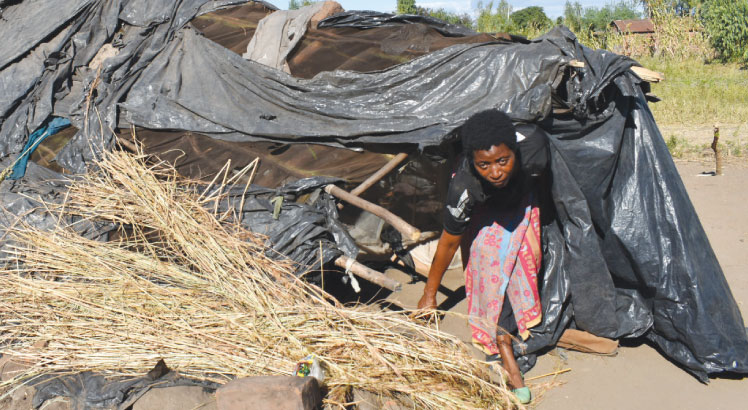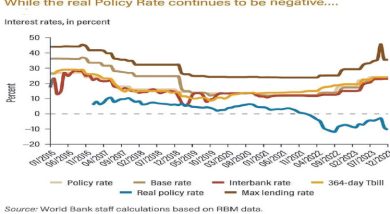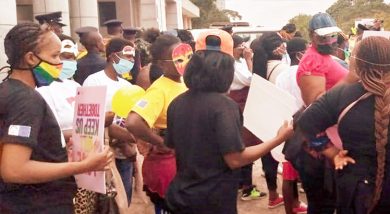Cyclone leaves indelible loss
On March 14 2023, Joyce Yuda, 52, fled floods induced by Cyclone Freddy as they reduced her three-bedroom house to rubble in Ngundu Village, Traditional Authority (T/A) Mwambo in Zomba District.
She could only grab a sweater and wrapper cloth as water rose to window level around 3pm.
“Had my husband not pulled me out through a flooded window, the house would have crushed me,” recalls Yuda.
Her family of seven took refuge at Chimwemwe Evacuation Camp in T/A Mwambo with survivors from 346 other displaced households.
“Most of us escaped with only clothes we wore the day the tragedy struck,” says camp chairperson Philemon Tcheni.
Yuda’s husband, George Chizimba, says they did not expect to be hit by flooding caused by the tragic torrents that battered the Southern Region for six days.
The relentless downpour triggered flooding in the hugely deforested Shire Highlands where silted rivers easily burst their banks when it rains.
Chizimba says he expected the flooding to occur in the Shire Valley districts of Nsanje and Chikwawa when he heard warnings from the weather department on the radio a week earlier.

On March 7, the Department of Climate Change and Meteorological Services warned about “a high likelihood” that the world’s longest-lasting cyclone would “continue moving towards Southern Malawi”.
The weather experts cautioned that Mulanje, Phalombe, Chiradzulu, Thyolo, Zomba, Blantyre, Neno, Mwanza, Nsanje and Chikwawa lay in the eye of the tropical storm that dumped devastating winds, rains, flash floods and landslides on its way from Madagascar via Mozambique.
The weather department advised people in danger zones to vacate or reinforce their buildings if necessary.
However, not many heeded the call to move to safer grounds.
By March 11 2023, the Shire Highlands especially Blantyre was hard hit.
The International Meteorological Organisation estimates that Cyclone Freddy dumped on Malawi’s southern Region the equivalent of six months’ worth of rainfall in six days.
Mulanje, Thyolo, Phalombe, Zomba and Chiradzulu had suffered the brunt of the unyielding downpour.
The rainstorm left many affected areas unreachable, destroying roads, homes, crops, livestock and anything in its path.
The Department of Disaster Management Affairs (Dodma) estimates that the cyclone affected more than 2.2 million people in Malawi, leaving 659 278 displaced, 679 confirmed dead and 530 people declared missing.
Rose Thuboyi of Ngondo Village in Nsanje has survived seven major cyclones that have hit Malawi since 2019.
However, she says Freddy reduced her to a beggar.
“The floods damaged my house and took away everything that was in it, including livestock, while I was still struggling to recover from Cyclone Ana, which occurred in January 2022,” she explains.
The latest cyclone ripped her farmland into a river, worsening hunger and poverty for the elderly woman and her two grandchildren.
The three now eat once a day and depend on alms as humanitarian aid for cyclone survivors is drying out.
Their plight exemplifies how the poor in least developed countries suffer the worst pangs of climate change fuelled by carbon emissions from wealthy nations.
This leaves the worst-hit communities in “a poverty-environment trap,” reports the United Nations Research Institute for Social Development.
Post-disaster needs assessments by the Government of Malawi and its partners estimate the loss at $506.7 million and the total cost of recovery and reconstruction is $680.4 million.
“The country faces huge financial constraints when it comes to disaster management,” says Dodma spokesperson Chipiliro Khamula. “Recovery and intervention needs are higher than the available resources.”
The funding shortfalls come amid outstanding deficits to help the battered region recover from Cyclone Ana, which affected one million people, displaced 190 000 and killed 46.
In 2019, Cyclone Idai damaged goods and services worth $220 million, but government only mobilised $80 million from the estimated $370 million required for recovery effectively.
This year, Malawi struggled with the aftermaths of Cyclone Freddy despite President Lazarus Chakwera’s appeal for external assistance.
However, the loss and damage can only get worse as disasters get more frequent and devastating due to climate change.
The Met Department’s forecasts that the country will continue to experience more extreme weather events, including intense cyclones.
Head of public weather services Yobu Kachiwanda says the country is vulnerable due to its proximity to the south western part of Indian Ocean where the cyclones develop and intensify.
“Land degradation, poor settlement locations and poor infrastructure development that does not accommodate climate information in the designing also increase the susceptibility of Malawi to cyclones,” he explains.
As cyclones become more intense and repeated, the likes of Yuda and Thuboyi need external support. They say the desired shift to safer places and resilient housing will be long and too costly for those who lost almost everything in the eye of frequent storms.





